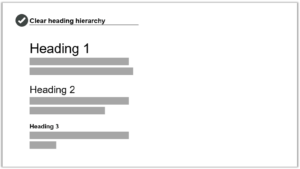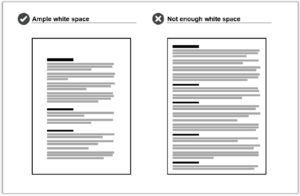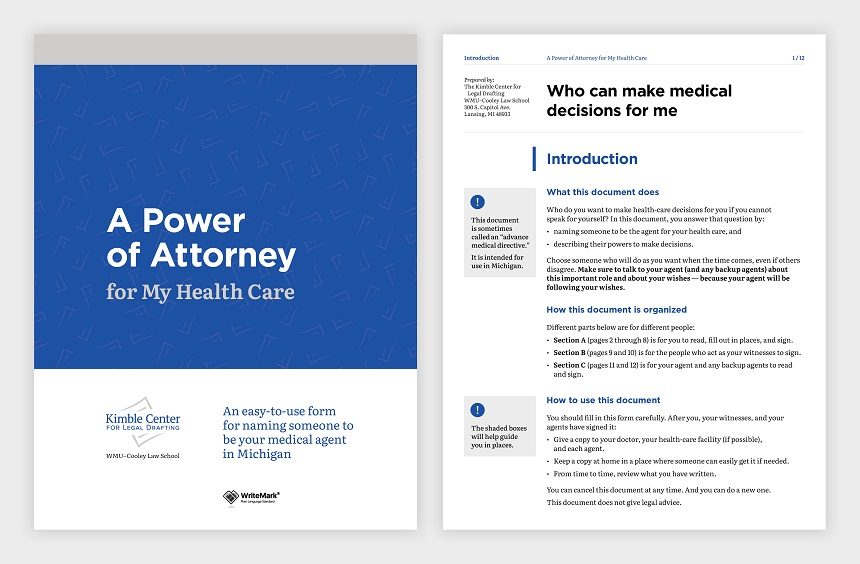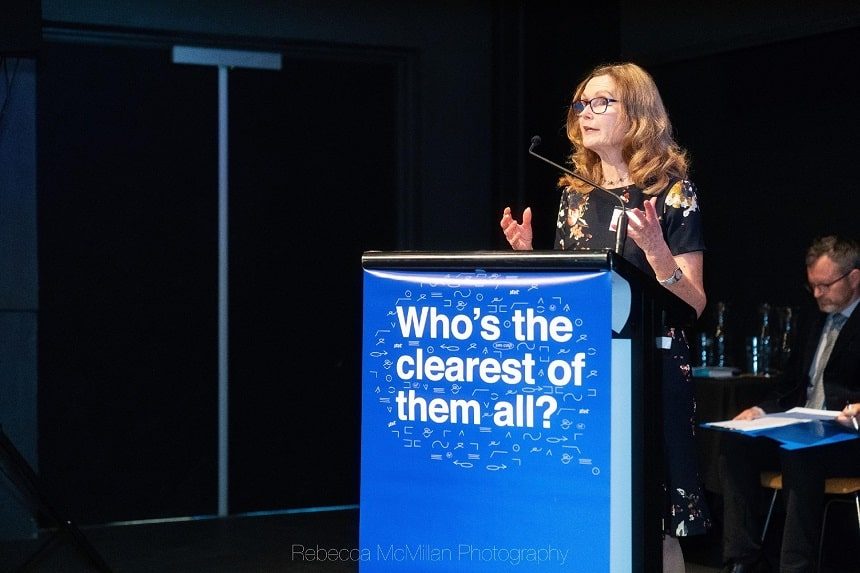WriteMark
Plain Language Standard
Understanding the WriteMark® design guidelines

Follow the WriteMark design guidelines to create clear, welcoming documents that your readers will love. Image by Sarah Pflug / Shopify licence
One of the criteria we use to evaluate documents is actually a bundle of requirements in one question: ‘Does the document meet the WriteMark® design guidelines?’
What are the design guidelines? Why are they important? And how can a document meet them? Today’s blog walks you through the design guidelines and explains why they’re part of the WriteMark® Plain Language Standard. Click the link below to see the design guidelines for yourself.
Download the WriteMark® design guidelines
The design guidelines ensure a document looks clean, clear, and accessible
The WriteMark® design guidelines cover four main areas, which we’ll explore in detail below.
- Text and headings
- Spacing and margins
- Graphics and colour
- Navigation
The guidelines ensure documents are inviting and easily legible. They favour simplicity over complexity, and support a clean, open, and accessible reading experience (without compromising brand look and feel).
Like the text and ‘big picture’ elements of the WriteMark®, the design guidelines prioritise the reader. They create a reading experience that aids navigation and understanding. Most importantly, they make documents work for the widest possible audience, by ensuring vision-impaired readers can access and use them.
However, the WriteMark® design guidelines are not a comprehensive resource for creating accessible documents.
Check out our blog posts on accessibility for more tips
Text and headings — ensure fonts are legible and headings aid navigation
The text elements of the WriteMark® design guidelines are mostly satisfied by choosing an easy-to-read typeface and a clearly legible font size. ‘Easy-to-read’ is slightly subjective, but as long as it’s not too light, narrow, or heavy — and you minimise bold, italics, and capitals — it should meet the standard.
The actual size of text, and how easy it is to read, depends on the typeface you choose. We usually recommend a 10-point minimum font size, but some typefaces may need to be bigger or smaller.
Headings help readers skim-read to find the information they need. To do this, they need to be formatted in a clear hierarchy (for example, top-level headings are the biggest, then second-level headings, and so on). Font size, weight, and colour can all work to distinguish different heading levels. Italics and underlining can work too, if needed.

Use a clear heading hierarchy to show the relationship between different sections and subsections in text. Image by Write Limited
The spacing above and below headings should put them closer to the paragraph they introduce, rather than ‘floating’ equally between the text before and after.
Finally, avoid ALL-CAPS and Title Case in headings — sentence case is easier on the eyes.
Spacing and margins — use white space to create an inviting layout
As readers, our eyes are drawn towards a roomy layout with plenty of white space (meaning parts of the page with nothing on them). On the other hand, a dense ‘wall of text’ looks and feels like a struggle to read. These can drive readers away.
To achieve a spacious layout:
- use generous margins and spacing to create white space around your text
- use ample and consistent spacing between lines and paragraphs.
A 2.5cm or more margin is good for printed documents. Microsoft Word uses 2.54cm margins (or 1 inch) by default.

Wide margins and generous spacing create ample white space. A page without enough white space looks cluttered and feels like a chore to read. Image by Write Limited
Comfy margins, spacing, and font size should also create a readable line length. Line length is the number of words or characters on each line of text. We recommend aiming for 45–75 characters per line for printed text. Longer line length can look and feel like a chore to read.
Use spacing to show the relationship between different elements on the page
You can also use spacing to support navigation. Readers automatically recognise a kind of ‘layout language’ created by grouping and aligning certain elements. Use spacing to reinforce elements that are connected, and create breaks between elements you want to separate.
More specifically, our design guidelines recommend you:
- use line spacing to visually group bullet lists with the text that introduces them
- align images with margins, and place them close to relevant text and explanations.
Graphics and colour — choose images that support text and use contrasting colours
If your document includes graphics, make sure they clearly support or clarify the text. Graphics that are only tangentially related to the text can throw readers off-course. Check that graphics have the necessary captions, titles, or labels as appropriate.
Graphics need to be easily legible without zooming or squinting. Consider the different ways readers will encounter your graphics (for example, printed or online), and make sure they are large and clear enough across all of the options.
To accommodate visually impaired readers, make sure graphics have either:
- alt text — short descriptions for simple photos and illustrations
- long descriptions — detailed explanations of complex elements, like graphs.
Check that the colours you use have a strong enough contrast to be easily legible. If colours are too similar, some elements become difficult to read — especially for colour-blind readers. Use a tool like Colour Contrast Analyser to check your colours, and be aware that smaller fonts need higher contrast.
Download Colour Contrast Analyser
Navigation — create well-defined sections and include a table of contents
Finally, use design to help readers navigate through your document.
We’ve mentioned already how heading hierarchy and spacing can help readers understand the relationship between sections and subsections in a document. Here are some more tips to improve navigation.
- Make each new section obvious (consider a page break if space allows).
- Include a table of contents for documents longer than two or three pages.
- Make sure the table of contents has ‘leader lines’ between the section heading and page number.
- Check that all links in digital documents work, including in the table of contents.
Trust your gut
Our final tip is not written in the design guidelines: trust your gut!
Implementing great design takes skill and experience. But recognising good design is something anyone can do.
Put yourself in your reader’s shoes. Take a step back and look at your document — does anything look unbalanced, or busy? Is your eye drawn where it needs to go? Does the density of text feel light and digestible, or does just looking at it make you want to close the window and take a coffee break?
Your own reaction is instructive, because it may indicate how other readers will respond to your document’s layout.
Follow the design guidelines — and trust your gut!
Download the WriteMark® design guidelines
Ryan Tippet July 9th, 2024
Posted In: The WriteMark
Tags: accessibility, clear communication, clear thinking, clear writing, design, design guidelines, guidelines, plain language, Quality writing, the WriteMark, WriteMark
Three reasons to get the WriteMark® on shorter documents

We’d love to help you achieve the WriteMark on the whole library of documents you use to communicate with customers | Photo by Niklas Ohlrogge on Unsplash.
Most documents that hold the WriteMark® are on the longer side. Achieving the Standard takes time and effort. That time and effort feels better spent when — at the end of it all — you can proudly display the WriteMark® logo on an important 100-page document, rather than an everyday 1-pager, right?
But which of your public-facing documents do people look at most often? Which do you think your customers are more likely to read from start to finish?
You’ll get the best value out of the WriteMark® by achieving the Standard and displaying the logo on the documents that are most important to your readers. We’re willing to bet they’re not always your longest.
Here are three reasons why the WriteMark® is right for shorter documents.
1. Short documents often leave a bigger impression on your readers
Consider which of your public-facing documents are the most important to you, and which are the most important to your readers. Are they the same documents? Or are you overlooking other documents that have more impact on your customers’ experience?

Your longest documents might seem the most important, but readers often spend more time and engage more deeply with short, everyday documents |Photo by Beatriz Pérez Moya on Unsplash.
For example, lots of insurance product disclosure statements in New Zealand hold the WriteMark®. A product disclosure statement (PDS) is the main policy document that sets out all the benefits, exclusions, terms, and conditions of cover. It’s an important document for both insurers and their customers.
But many customers will never read their PDS cover to cover. They’ll dip into a few sections as and when they need them. Making the PDS as clear as possible is still vital, but it’s unlikely to be the document that insured customers spend the most time with.
Instead, those customers spend more time on shorter documents: things like policy schedules, application forms, renewal letters, claims processes, websites, and correspondence. These ‘satellite’ documents may seem less important, but they’re the ones customers are actually reading. As a result, they play an outsized part in building confidence and trust.
That’s why getting short documents right can make a big difference, and leave a bigger impression.
2. WriteMark® requirements make short documents focused and functional
The WriteMark® Standard has 25 requirements, ranging from the ‘big picture’ (things like smart structure and clear purpose) to the minute details of language and presentation. Some of these 25 requirements won’t apply to short documents — this makes them easy to meet!
But for many short documents, the WriteMark® requirements can help you consider improvements you might otherwise overlook.
For example, you might think:
- structure is less important when all your information fits on one page
- headings aren’t needed for a document of only a few paragraphs
- a bullet list is unnecessary when you’re only asking a reader to fill out a form.
But following the WriteMark® requirements for structure, headings, and bullet lists — among other things — hones short documents to make them their best, punchiest, most practical versions:
- A smart structure ensures you deliver information in a logical order, so readers build their understanding and know what to do.
- Headings summarise key messages, clarifying purpose and supporting navigation.
- Bullet lists enable readers to scan information easily and create extra white space.
All these elements make long documents simpler and more functional, but here’s the secret: they work for short documents too!
3. Customers expect consistent quality across the documents they read
Displaying the WriteMark® on your biggest documents is a visible commitment to caring about your customers. Adding it to the surrounding constellation of shorter documents creates consistency in your brand values across all your communications.
Customers expect consistency from the businesses and organisations they deal with — even subconsciously. A poorly written webpage or letter template will stand out like a sore thumb. One complex and ambiguous communication can undermine the caring and conscientious brand value reflected in the WriteMark®.
If you can make something as complex as an insurance PDS clear, why leave a claims form or FAQs page in the dense and ambiguous Dark Ages? Achieving the WriteMark® on shorter documents signals a consistent, clear tone across the whole array of interactions you have with your customers.
We can assess short documents in batches, so the WriteMark® is more cost-effective
If you’re concerned about the cost, we can work out a deal. Because it doesn’t take as long to assess short documents, we’re often happy to do them in batches.
This makes it even more cost-effective to achieve the WriteMark® for your ‘daily drivers’ — those short, significant documents that your readers encounter every day.
We’d love to help you get the WriteMark® on your library of short documents. Contact us today to discuss your documents, your readers, and to get a quote.
Send us some information about your short documents and we’ll be in touch
Ryan Tippet June 12th, 2024
Posted In: The WriteMark
Tags: clear communication, financial documents, Insurance writing, Legal documents, WriteMark
Why the WriteMark® matters more than ever in the age of AI writing

Photo by cottonbro studio / Pexels licence
One of our favourite plain language mottos adorns the wall in massive text at Write’s Wellington office. It’s from Sir Ernest Gowers’ book, Plain Words: ‘Be short, be simple, be human’.
It’s a motto that follows its own advice.
In the burgeoning age of ‘AI’ text generation, human writing for human readers is more important than ever. And that makes the WriteMark® an even more valuable symbol of people-centric plainness.
Here’s why a quality mark for clear communication matters even more in the age of AI.
People-centric writing stands out in an AI-generated torrent
The WriteMark® has always been a way to show your readers you care.
The heart-shaped symbol demonstrates your commitment to being clear, open, and customer-focused. It signals to your audience that you’ve gone the extra mile to ensure they understand what you’re telling them, which builds trust and confidence.
We think readers will particularly appreciate the WriteMark’s® quality promise as AI writing proliferates. AI-generated text risks ‘infecting’ AI training data — the library of information that AI tools use to create their responses. This may degrade the quality of AI outputs over time, as they reinforce and amplify their own distortions and biases. Commentators have called this an ‘AI ouroboros’
Read about the ouroboros on Medium’s website
In this uncertain future of AI writing, the WriteMark® will signify people-centric writing that gives readers confidence and helps to form human connections between author and audience.
Our human assessors give human insights
In a WriteMark® assessment, qualified experts read documents, assess them against 25 carefully selected criteria, and produce a report packed with insights and recommendations. They apply a critical eye, drawing on their experience and understanding — as both writers and readers — to identify what works and what needs work. This experience and insight helps to shape documents that serve their writers — and their readers.
AI can do some incredible things, if you know how best to use it. By drawing from untold libraries of human writing and thought, it can generate convincing text and images in the blink of an eye. It can educate and entertain, adapting its tone and language for any conceivable audience. But AI is not critical, creative, or insightful — not yet.
Big-picture elements require critical thought
AI can provide lots of helpful advice for some of the more mechanical aspects of plain language, like sentence structure and word choice. But humans can still do a few things better — like thinking.
‘Artificial intelligence’ is a bit of a misnomer, because tools like ChatGPT and DALL·E 3 are not thinking or creating. They draw on vast sets of training data from the web and use predictive patterns to spit out realistic answers to prompts.
This means AI would struggle to meet or assess some WriteMark® criteria, especially big-picture elements. It takes critical thought to determine whether a document has:
- a clear purpose
- an overall structure that helps readers to understand it
- answers to all the questions a reader is likely to ask.
AI is improving constantly, and quickly. But answering these questions requires critical analysis and holding the ‘big picture’ in mind — skills that today’s AI tools can only imitate.
AI can be a cultural liability
Our assessors have another advantage over AI tools — their Kiwi cultural context and sensitivity.
AI tools draw on training data from all corners of the internet. This means they tend to replicate and reinforce existing biases in that data. Aotearoa New Zealand represents a tiny corner of the internet, so our cultural differences are easily overwhelmed by American and European norms in AI’s predictive patterns.
Why does this matter? One element we assess for the WriteMark® is whether the document has an appropriate style and tone for its audience. Aotearoa’s cultural context is different from the rest of the world in lots of small ways — as well as the big ones, like the role of te reo and te ao Māori. The words we use and the way we express ourselves are distinct, as are our history, economy, politics, and culture.
AI tools are liable to get these small things wrong, because they draw from the wilderness of the World Wide Web. As well as setting the wrong ‘style and tone’ for our specific cultural context, relying on AI can lead to embarrassing and even offensive errors.
The WriteMark® Plus gives unrivalled insight into how readers experience a document
On top of using human experts to assess documents for the WriteMark, we get human non-experts to test how well a document serves its readers for the WriteMark® Plus.
User-testing with real readers always uncovers unforeseen sticking points. Human testers can help identify things like:
- whether a certain word choice or section is confusing
- whether a document’s structure matches readers’ expectations
- whether a document is accessible to readers of all abilities
- whether a document is practical to use in the real world.
AI is clever, and convincing. But there’s simply no substitute for testing a document with its target audience.
AI can be a powerful plain language tool — learn how to use it safely
While human expertise can’t be beaten when it comes to the high standard of the WriteMark, we still recognise the value of this powerful tool.
That’s why Write has added an Write smarter with AI workshop to our roster, and why we’re keeping up to date with advances in the field.
Check out our workshop, Write smarter with AI
Read our blog post about how to get the most from AI
Ryan Tippet February 12th, 2024
Posted In: Plain English, Plain language, Plain Language Awards, The WriteMark, WriteMark Plus
Tags: AI, AI Writing, clear communication, clear language, clear thinking, clear writing, plain language, power of plain language, Quality writing, the WriteMark, WriteMark, WriteMark Plus
Using words for good — an experiment in the power of care

Lynda Harris conducts an experiment in the power of care through plain language. Image by DaMoJo / Excio licence
This B Corp month (March 2022), Lynda Harris explores links between being a B Corp and using words for good. Write, the company behind the WriteMark® and WriteMark® Plus, became a B Corp in 2021.
This blog was written for accredited and aspiring B Corps. But the ideas are relevant to all business writers!
Does being a B Corp improve the way you write? It certainly does for some B Corps.
A few years ago, I did a small experiment with some B Corps to see if their focus on being a force for good in the world influenced the way they wrote. And it did! I don’t know if all B Corps write clearly. But I do know that being a B Corp will give you a great head start.
Find out more about B Corps in Australia and New Zealand on the B Corp website
What made me do that experiment?
As a plain language professional for over 30 years, with a passion for training people in the art of clear communication, I’d seen some people transform their writing overnight simply by being encouraged to apply the age-old ‘golden rule’. Asking a writer to treat their client as they would like to be treated and ‘walk a mile in their shoes’ sometimes trumped more formal writing techniques. And almost instantly writers produced much clearer, more reader-friendly documents.
Since the notion of honouring ‘people and place’ is baked into B Corps, I wondered if the foundational concepts of care and empathy would naturally translate into a more effective, human-centred writing style from those firms.
Testing my idea
So I decided to find out if my hunch was right and interviewed several B Corps. To raise the bar, I picked a sector traditionally known more for obfuscation than clarity — law firms!
Here are some of the inspiring responses to my all-important question, ‘Do your B Corp values, especially your value of care, influence the way you write to clients?’
From Alexandra Doig, Managing Partner of Atticus Lawyers in Melbourne:
Yes! Telling people what they need to know and doing all we can to help, means we need to write like a human. We need to communicate clearly and personally in ways that don’t alienate. We can’t give a client a convoluted document. We have to walk the talk and act on what we believe in.
We could write a 10-page document. We try to write a 1-pager that clearly captures the most important info and that the client can easily understand and be comfortable with. It’s a calculated risk — with benefits. We want to write in a way that gives clients that lightbulb moment If a client doesn’t walk away with a greater understanding of their position than they had when they arrived, we haven’t done our job properly.
From Joel Cranshaw of Clearpoint, Australia
Yes! I say that for two reasons. Our retainer-based fee model means that we must work efficiently — so we must be clear, concise, and to the point. And what we believe in, our philosophical approach to compassionately meeting clients’ needs, also means that we must communicate in ways they can readily understand.
From Sophie Tremblay of Novalex, Canada:
Absolutely! We know that even the smartest people aren’t necessarily familiar with legal terms and concepts. So a huge part of what we do is to make the law understandable. We use concrete examples and remove the abstract, along with many other techniques such as metaphor (it’s like), and ‘this means’… We remove jargon and make important concepts stand out. We do what we need to do to be understood.
Accidentally using plain language techniques
Hearing Sophie’s list of useful plain language techniques, I asked if she had ever had any formal plain language training. She hadn’t. Nor had Alexandra, or Joel. Yet instinctively, motivated by strong human values and a sense of care, all three ticked so many plain language boxes.
Here’s what a sense of care, and a desire to connect and be helpful, prompted these firms to do:
| Keep the content as concise and relevant as can be — thinking very carefully about what the client needs and sticking to that, avoiding cognitive overload | ✅ |
| Use a layout that is carefully organised and makes important points stand out | ✅ |
| Make it personal, putting yourself in your reader’s shoes, being ‘compassionately reader-centred | ✅ |
| Focus on clarity, explaining concepts in a way non-lawyers could understand | ✅ |
| Use metaphor or simile (it’s like) and reader-friendly interpretations (this means) | ✅ |
| Avoid jargon | ✅ |
Without knowing it, they applied these key principles of plain language:
- a highly personalised approach aimed at connecting and truly helping
- clear organisation of content focused on achieving a specific purpose
- clear, familiar language and a major attempt to explain unfamiliar concepts
- a layout that signals key messages and supports comprehension.
And while achieving the above, they naturally applied more detailed concepts of plain language, such as writing in the active voice, favouring verbs instead of nouns, writing strong informative headings, and so on.
Since doing those interviews, I have informally looked at the websites of many other B Corps. My sense has been that a good number show a higher standard of clarity and connection than their non-B Corp competitors. And some are outstandingly clear and inviting.
So what do the results of my experiment mean for you?
First it means that your B Corp values are most likely influencing you to write with more care. That’s great! But rather than assuming, why not test your writing against a recognised plain language standard? You can download the Write Plain Language Standard here for free and use it as you wish in your organisation. Quite apart from putting your writing to the test, using the Standard will help you label some of the good practices you may already have and teach you some you weren’t aware of.
For some, perhaps those creating and retailing products, the focus on plain language may be easier.
But for others, working in industries known for complex concepts and language, it will be a bigger challenge. However, if lawyers can do it, you can too, right? (Shout out to Sharesies, the Cooperative Bank, Pathfinder, KiwiBank, and others who prove you can write warmly and clearly in the financial sector too!)
What’s the deal with plain language anyway?
It’s probably pretty clear to you by now that striving to create clear, human-centred writing has many practical benefits.
When you focus on the purpose of an email, you’re more likely to get understanding and the action you’d hoped for. When you focus on what the user needs to know, and begin with action words in a set of instructions, your user is more likely to follow them. When you put just the right content in a report, and use informative headings, your reader is more likely to keep reading. When you write your terms and conditions with a reader-friendly tone, using everyday words and making key messages clear, people are more likely to feel positive about them.
And at the big-picture level, plain language is essential to a functioning democracy in which all people can access their rights and understand their obligations. Human-centred writing makes everything work better.
But here’s the most important bit for you
Actively applying the ethos and principles of plain language creates a beautiful congruence between your values and how you show up in the world. It’s about authenticity and speaking in a voice that truly reflects who you are. It’s really at the heart of being a B.
- Find out more about B Corps in Australia and New Zealand on the B Corp website
- Download the Write Plain Language Standard
- Read about the benefits of plain language
- If you’re in New Zealand, support the Plain Language Bill by making a submission
- Ask us about getting the WriteMark® on your documents
Lynda Harris March 22nd, 2022
Posted In: Plain language, The WriteMark, WriteMark Plus
Tags: b corp, human-centred language, plain language, using words for good, WriteMark
Kimble Center’s healthcare form awarded ClearMark

The Kimble Center's Power of Attorney for healthcare goes to new heights | Photo by Brands&People on Unsplash
Could the Kimble Center for Legal Drafting’s Power of Attorney for healthcare win any more accolades? Turns out the answer is a definite ‘yes’.
The ClearMark Awards judged the healthcare form worthy of the award for best legal document. The ClearMarks are organised by the US Center for Plain Language and recognise the best plain language communications created by organisations in North America. The Center’s Barbra Kingsley and Alex Miranda announced the 2021 winners as part of the Access for All virtual conference in May.
The judges said about the power of attorney that:
[it] is a wonderful example of making legal text accessible.
And they went on to say:
The writers conducted several different kinds of user testing, including with health professionals and typical lay users. They also benefited from input from the Center’s international board members and PL (plain language) experts in New Zealand. The effort shines through. It’s an exemplary piece, worthy of being winner in its category.
View the list of ClearMark winners
Read about the ClearMark award in an article by Oakland County Legal News
Taking legal documents to new heights
The Kimble Center for Legal Drafting paves the way for innovative, accessible legal documents. This article on the Center’s website describes its origins and goals.
People can use the Power of Attorney document to set up a person they trust to make decisions about their healthcare if they’re not able to. The Power of Attorney is easy to understand and fill out — and it’s free to use for US citizens.
More than 1000 people have used the form since it was published.
Find out more about WriteMark® Plus — the ultimate in communication excellence

Design elements guide the user through the document. Image by Gusto Design.
Anne-Marie Chisnall May 21st, 2021
Posted In: The WriteMark, WriteMark Holders, WriteMark Plus
Tags: accessibility, ClearMark, Joseph Kimble, Kimble Center for Legal Drafting, Legal documents, plain language, WriteMark, WriteMark Plus
A plain language love story

Image by Andre Furtado / Pexels licence
We’re head-over-heels for plain language, and we’re always excited when we find others who share our passion. Take Southern Cross Travel Insurance (SCTI): we’ve just awarded the WriteMark® to their new domestic travel policy.
SCTI decided the time was right to offer an insurance policy that would help New Zealanders feel safe and secure when travelling around New Zealand. The WriteMark® shows that SCTI is dedicated to bringing their customers a policy that’s clear and easy to understand.
Nick Bassett, Acting Head of Sales, Product and Marketing, says they wrote the policy with their customers in mind:
We’re committed to providing our customers with excellent service, and knowing what they’re covered for when they buy their policy is incredibly important. The WriteMark® stamp is an endorsement of transparency and integrity, which is why we’re so pleased to have launched our first policy document in plain language, and to have achieved this recognition.
To celebrate, we’ve created a video that showcases everything there is to love about an insurance policy with the WriteMark®.
Your customers deserve a policy that understands them
Insurance should give us peace of mind because we know we have support in times of stress and uncertainty. A policy written with everyday words, short sentences, and useful headings locks in that peace of mind, because you know exactly what you’re covered for.
By writing your insurance policy in plain language, you’re showing that you care about your customers and can think from their perspective. Your transparency will help build their trust.
Learn more about writing insurance policies in plain language
Want to start your own plain language love story? Ask yourself what your reader needs from you, and make sure you deliver it in a way that’s easy to understand.
Insurance cover is complicated, and your readers will thank you for finding a way to lead them through it, without all the jargon. You’ll find lots of helpful tips in our easy-to-use checklist — the Write Plain Language Standard.
Download Write’s free Plain Language Standard
Take our Plain Language Foundations online course
Read our recent blog post on how plain language can help institutions win back trust
Find out more about getting a WriteMark® assessment
Anne-Marie Chisnall September 14th, 2020
Posted In: The WriteMark, WriteMark Holders
Tags: Insurance writing, plain language, policy writing, WriteMark
Writers and WriteMark®: Partners in care

Set up a partnership of care through the WriteMark process. Image by Isaac Quesada / Unsplash licence
So, believing what you do about the power of plain language, my question to you as both writer and consumer is, ‘What action can you take that is bigger and bolder than before?’ How can you make your sense of care count?
Lynda Harris, Chief Executive of Write and WriteMark®, talked about care as a catalyst for change in her speech at the Plain English Awards ceremony in November 2018. She went on to say:
Make your effort meaningful! What significant project needs your support and insights? Which of your reader groups are most in need? Who must you persuade? Where can you make a difference?

Lynda Harris urges writers and readers to care about clarity at the 2018 Plain English Awards. Image by Rebecca McMillan Photography / CC BY-NC
One way to make a bold and meaningful difference is to earn the WriteMark® Plain Language Standard on your document or website. This mark of ‘care in action’ isn’t necessarily easy to achieve, but the payoff is powerful. To meet the Standard, you’ll need to be committed to the process — and persistent.
The rigorous WriteMark® process sets up a partnership of care where document creators commit to plain language for their readers. Documents that reach the Standard have been checked against 28 elements covering purpose, structure, content, language, presentation, and accuracy. WriteMark® Plus adds user-testing with readers to the mix as well.
Discover more about the WriteMark elements of plain language
How to set up a partnership of care with the WriteMark
The writers, editors, designers, legal teams, and others who create WriteMark®-ready documents often work together for a long time. The WriteMark® review recognises the work everyone has put in so far and checks for any final changes needed to achieve the Standard.
If you start on the WriteMark® journey, you’ll need to consider feedback from your WriteMark® assessor. The document will probably change as your team considers the feedback and decides how to implement it. If you aim for WriteMark® Plus, you’ll also get feedback from real readers who reflect the characteristics of your intended audience.
Whatever the source of the feedback, you’ll know that it’s intended to help shape your document into one that exemplifies the best of plain language for the benefit of all readers. A document that reflects the care of all the professionals who have crafted it — and care for the readers who will ultimately read, understand, and act on it.

Set up a partnership of care through the WriteMark process. Image by Isaac Quesada / Unsplash licence
A Deed of care for the future
Once you’re on the way to achieving the Standard, you’ll sign an agreement called the WriteMark® Deed. The Deed sets out our WriteMark® relationship and explains how it works now, and for the future.
We’ll both celebrate and spread the news, hoping to inspire others to aim high for clarity and care for their readers.
Read about a WriteMark® project to rewrite an insurance policy
Join a face-to-face workshop on plain language principles
Get access to Write Online: videos and microlearning from the leaders in plain language
Anne-Marie Chisnall February 24th, 2020
Posted In: The WriteMark